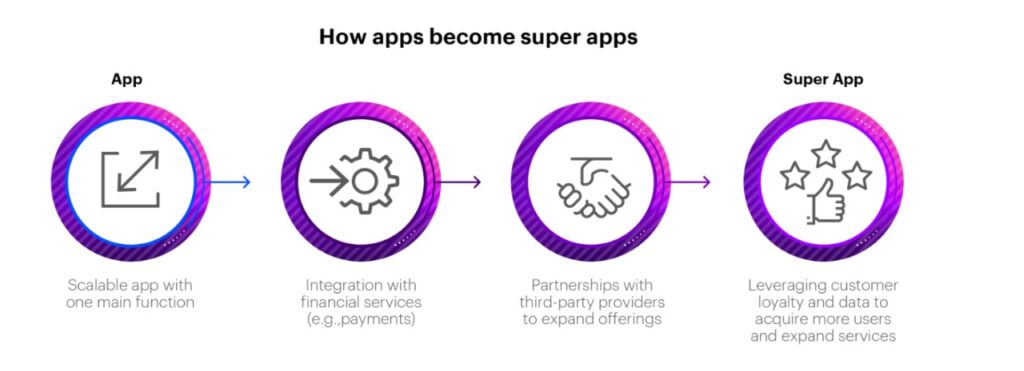Super apps are all-in-one platforms that combine multiple services and functionalities, catering to various user needs. These apps provide convenience by allowing users to access a multitude of services without switching between applications.
Glovo, a Spanish-based Super App provides on-demand delivery services. Users can order a wide range of products, including food, groceries, pharmaceuticals, flowers, and more. Glovo also offers courier services to send packages or documents.
Introduction To Super Apps Like Glovo
Glovo’s core features include real-time tracking, secure payments, user ratings, and a seamless user experience. Here, we discuss how much it would cost to develop a super app like Glovo.
Glovo, offers services such as food delivery, grocery delivery, courier services, and more. Users can order food from restaurants, purchase groceries, send packages, and even request services like laundry or pharmacy delivery.
Cost to Develop a Super App like Glovo
| Country / Region | Pricing | Timeline |
| New York – USA | $300,000 – 350,000 | 9 – 12 Months |
| Kyiv – Ukraine | $275,000 – 300,000 | 8 – 12 Months |
| Croatia – Europe | $250,000 – 300,000 | 9 – 12 Months |
| Philadelphia, USA | $300,000 – 350,000 | 8 – 12 Months |
| Hanoi – Vietnam | $60,000 – 100,000 | 10 – 14 Months |
| India | $30,000 – 75,000 | 8 – 11 Months |
Understanding Core Features and Functionalities of Glovo
We shall delve into the importance of an intuitive and user-friendly design. Also find an overview of key UI/UX features and the cost of designing an appealing and seamless user interface.
Multiservice Integration
Glovo’s core functionality, integrating various services into a single platform.
Integrating multiple services presents significant complexity. The app needs to handle diverse data sets, manage various APIs, and ensure smooth interoperability between different service providers.
The cost of integrating multiple services include development time, API integrations, maintenance, and potential scalability challenges.
Common services that can be integrated into a super app.
Super apps can integrate various services, such as ride-hailing, food delivery, grocery delivery, ticket booking, hotel reservations, bill payments, banking services, and more. The key is to identify services that align with the target audience’s needs and preferences.
The Appscrip podcast: The secret behind Glovo’s success
User Interface and User Experience (UI/UX) Design
Importance of intuitive and user-friendly design
A well-designed and user-friendly interface is crucial as users should be able to navigate seamlessly between different services and access all features effortlessly. Intuitive design increases user engagement, retention, and overall satisfaction.
Overview of the key UI/UX features present in Glovo.
Glovo’s UI/UX features begin with streamlined onboarding, clear and simple navigation, personalized recommendations, a robust search functionality, real-time order tracking, secure payment options, user ratings and reviews, and efficient customer support. These contribute to a seamless user experience.
Cost of designing an appealing and seamless user interface.
Designing an appealing and seamless user interface involves research, prototyping, graphic design, and usability testing. The cost depends on the complexity of the app, number of screens, level of customisation, and the design team’s expertise.
Geolocation and Real-time Tracking
Role of geolocation and real-time tracking
Geolocation and real-time tracking are vital. Geolocation identifies the user’s location accurately so that they can access nearby services. Real-time tracking on the other hand, ensures users can track the progress of their orders, ensuring transparency and control.
How Glovo utilises technologies for order tracking and delivery.
Glovo leverages geolocation to connect users with nearby restaurants, stores, and service providers. GPS technology determines the user’s location and displays options. Real-time tracking helps users track the delivery person’s location and ETA.
Cost considerations for implementing robust geolocation and real-time tracking functionalities.
Implementing robust geolocation and real-time tracking functionalities involves costs depending on complexity of the application, desired level of accuracy, and scalability requirements.
Costs include acquiring geolocation data, licensing map services, developing and maintaining tracking infrastructure, and ensuring server capacity to handle real-time updates.
Payment Gateway Integration
Overview of the payment system and the need for secure and seamless transactions.
The payment system provides users with secure and seamless transactions. Glovo provides various payment methods: credit/debit cards, digital wallets, and cash on delivery. The app securely processes payments, allowing users to complete transactions.
Integrating various payment methods and third-party payment gateways.
Glovo integrates multiple payment methods by collaborating with payment service providers, financial institutions, and third-party payment gateways. By this Glovo ensures users can seamlessly complete transactions via their preferred payment method.
Cost factors related to payment gateway integration and ensuring data security.
The cost factors associated with payment gateway integration include transaction fees charged by service providers, setup and integration costs, maintenance expenses, and compliance to security standards and regulatory requirements.
Data security is crucial for building user trust and investing in robust security measures such as implementing encryption protocols, security audits, and maintaining compliance with data protection regulations involves additional costs.

Scalability and Infrastructure
Importance of a scalable infrastructure to handle growing user demands.
Super apps possess a large user base and offers multiple services, therefore having scalable infrastructure is imperative. Scalability ensures the app can handle huge traffic, user registrations, service requests, and data storage without compromising performance or user experience.
A scalable infrastructure enhances reliability, meets the demands of a huge user base, and prevents disruptions during peak periods.
Cloud hosting, load balancing, and server architecture for a super app.
Cloud hosting has a pivotal role in the infrastructure of a super app. It provides flexibility, scalability, and cost-efficiency by leveraging cloud service providers such as AWS, Microsoft Azure, or Google Cloud Platform.
Cloud hosting enables easy scaling of resources, dynamic allocation of computing power, and high availability.
Load balancing is a critical aspect to handle high user demands. It involves distributing incoming traffic across multiple servers to prevent a single server from being overwhelmed. Load balancers ensure optimal utilisation of resources and enhances overall performance and responsiveness of the app.
Super apps typically employ microservices architecture. This divides the app into small, independent services that can be developed, deployed, and scaled separately. Microservices allow greater flexibility, fault isolation, and efficient development and maintenance of app features.
Cost implications of infrastructure development and ongoing maintenance.
Developing and maintaining a scalable infrastructure for a super app entails various costs. These include cloud hosting, load balancers, server instances, database services, content delivery networks (CDNs), and monitoring tools.
Costs depend on the size of the user base, expected traffic, and the cloud service provider. Ongoing maintenance costs entails monitoring, scaling, and ensuring the security and reliability of the infrastructure.
Backend Development and APIs
The backend development involves creating and managing components such as user management, service requests, payments, order tracking, and third-party integrations.
The backend handles large amount of data, ensures fast response times, and facilitates efficient communication. Technologies such as Node.js,
Python, Ruby on Rails, or Golang are commonly used for backend development in super apps.
APIs for seamless communication between various services.
APIs enable seamless communication between various services within a super app ecosystem. APIs allow integration of external services, such as payment gateways, mapping services, or delivery logistics providers.
Developing well-documented and robust APIs ensures smooth data exchange, efficient workflows, and a consistent user experience.
Cost considerations for a robust and scalable backend system.
Developing a robust and scalable backend system involves costs related to the initial architecture design, backend development, database setup, infrastructure provisioning, API development, and ongoing maintenance.
The complexity of the app, development team size, and the required infrastructure impacts the overall cost. Additionally, ongoing expenses for hosting, scaling, monitoring, and infrastructure upgrades must be factored into the long-term cost considerations.
Tech Stack While Developing A Super App Like Glovo
Frontend
- Framework: React.js or Angular
- Programming Language: JavaScript or TypeScript
- Styling: CSS or CSS preprocessors like SASS or LESS
- State Management: Redux or MobX
Backend
- Framework: Node.js with Express.js
- Programming Language: JavaScript or TypeScript
- Database: MongoDB or PostgreSQL
DevOps
- Continuous Integration/Continuous Deployment (CI/CD): Jenkins or GitLab CI/CD
- Containerization: Docker
- Orchestration: Kubernetes
- Infrastructure as Code: Terraform or Ansible
- Cloud Platform: Amazon Web Services (AWS) or Google Cloud Platform (GCP)
Architecture
- Microservices architecture for scalability and modularity
- API Gateway: Express Gateway or Kong
- Service Discovery: Consul or etcd
App: Mobile App Development: React Native or Flutter
Website
- Frontend: React.js or Angular
- Backend: Node.js with Express.js
- Database: MongoDB or PostgreSQL
Database
- Relational Database: PostgreSQL or MySQL
- NoSQL Database: MongoDB or Cassandra
Conclusion
Super apps like Glovo have revolutionised the way we order and receive goods and services. These platforms seamlessly integrate multiple functionalities into a single application, providing users with convenience and efficiency.
Entrepreneurs and businesses looking to foray into this domain have an able product that is built with robust and scalable technology platform that serves as the foundation for building a super app. The solution is built using modern technologies and frameworks, ensuring a seamless user experience across multiple devices and platforms.
Additionally, Appscrip offers ongoing technical support and maintenance services to ensure the smooth functioning of the super app.

After an Engineering degree and a Diploma in Management I devoted 16+ years working in the automotive industry. My innate skill and extreme passion in writing, encouraged me to adopt it up as a profession. I have been writing for more than 10+ years in the software industry. The 400+ blogs I published are informative, exhaustive and interesting to a professional and causal reader.








